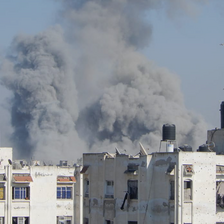The Electronic Intifada 17 June 2024

Adding color and defiance to Gaza’s gray.
Gaza’s youth go looking for anything that gives them hope.
They walk around the streets in this search, finding only destruction.
So they decide to be the hope.
The Gaza Strip is gray. Everything is rubble from destruction and bombardment. But after the Rafah invasion, in some cities, people have returned to what remains of their homes, to try to focus on their children again.
Some have decided to apply some paint, an attempt to furnish happy colors with graphics and graffiti expressing our feelings, expressing what we have on our minds.
Every painting has a meaning and a story.
Most depict the sense that hope is all we have in a situation from which there seems to be no way out.
One painting is very painful to look at. It was painted by a young man who lost his family under the rubble of their home. He drew his family and wrote next to the image: “My father was martyred here!”
You could say the painting was drawn with martyrs’ blood.
Our homes have become tents. Our lives have been nearly destroyed.
Israel is creative in its destruction, creative in destroying: houses, dreams, lives, calm, comfort, sleep, study, families.
The days have become hard, and Israel is a deeply destructive force, burning, attacking and targeting all things in a systematic way.
Qalaat Barquq
In the middle of Khan Younis, in the southern part of the Gaza Strip, is the Qalaat Barquq fort.
The fort dates back to the Mamluk era and was constructed during the rule of the Mamluk Sultan Barquq in 1387.
Only the front of the fort has survived into modern times, along with one of its towers, affectionately nicknamed the Tower of Bisa by locals.
But Israel’s military has targeted the area and reduced the tower to rubble.Israel’s targeting of archaeological and historical sites – including the nearly 800-year-old Church of Porphyrius, as well Gaza’s Central Archives, which housed historical documents dating back 150 years – is not merely an assault on our history and heritage
It is psychological warfare. It is an attempt to destroy our sense of ourselves and our connection to our land.
It is a central part of Israel’s genocide.
It is as central as the systematic bombardment of our homes, our factories and our offices. The UN estimates that more than 50 percent of Gaza’s buildings have been fully destroyed in Israel’s unhinged bombardment since 7 October.
We used to marvel at how resilient our buildings were during previous Israeli assaults. Yes, roofs and walls may have been damaged, but usually at least the pillars and most walls survived to be rebuilt.
Not this time. This time, Israel has planned its destruction with meticulous care, leaving neither pillar nor wall to witness the death of love, just like it has targeted Gaza’s children, killing nearly 15,000 and leaving some 19,000 orphaned.
Alone as pillars.
Sad as tears.
Gray as ashes.
Gloomy as the sky.
He does not know what tomorrow holds.
Isolation
In Gaza, we did not live like people in other countries even before Israel’s genocide.
But life was bearable, even sweet. We had the simplest things, at least: food, running – if dirty – water, electricity for at least some hours in the day.
In this genocidal war, we are deprived of all of that. We are even deprived of the internet.
This has real effects. With more and more families and individuals trying to leave Gaza, the lack of communication means those who go and those who stay cannot communicate.
Families are torn apart in more ways than one.

The inscription reads: “Hope itself is painful when it is all that is left.”
I have a brother studying in Egypt. But only on rare occasions can we speak. And only on those occasions can my brother learn of his family here.
Similarly, many freelancers in Gaza have lost their work because they cannot depend on a reliable connection.
Misery piles on misery.
On 21 May, I went out on the streets of Khan Younis to search for an internet connection. I walked from south to north before I finally found a signal.
I was happy as a child who found a toy he had been looking for for days. Importantly, there was a message from Dave, an Electronic Intifada editor, saying a story I had written would be published.
I had sent it in from Rafah, where there is good internet service.
While I was chatting with my brother, who is studying medicine in Egypt, I saw a news report about the evacuation of Kamal Adwan Hospital.
I immediately worked on this story and returned the following day to send it. But the network had crashed, so I went to another area where I knew there used to be an inconsistent network connection.
For three hours, the connection was only strong enough for my mother and I to send WhatsApp messages, however.
The next day, my mother called a friend, asking her if she knew anywhere the internet was available in Khan Younis. She mentioned a certain area, which it took us three hours of walking to reach.
There was no network.
We returned back to our shelter, another day lost.
Donya Ahmad Abu Sitta is a writer in Gaza.





